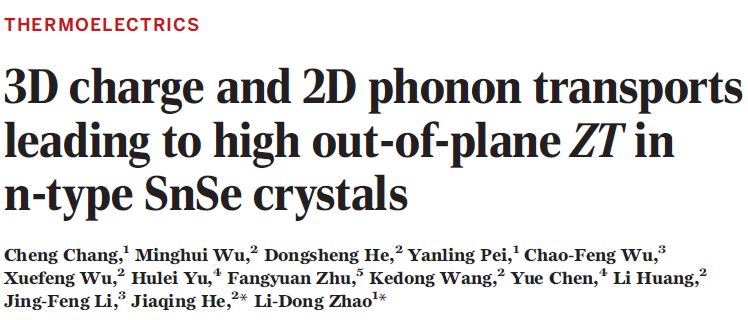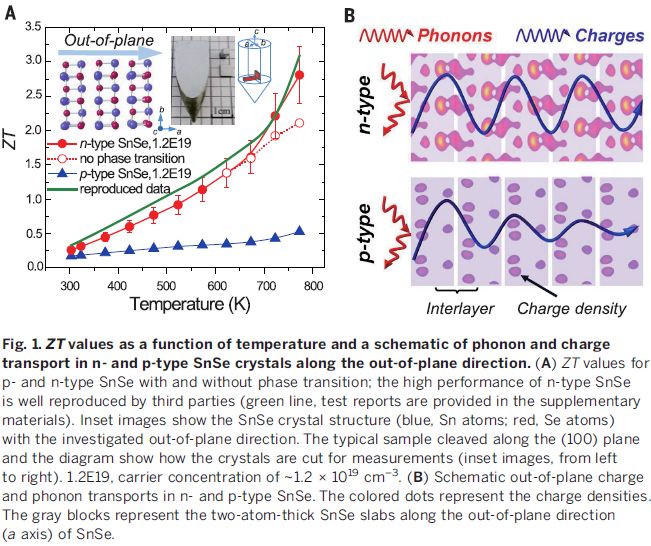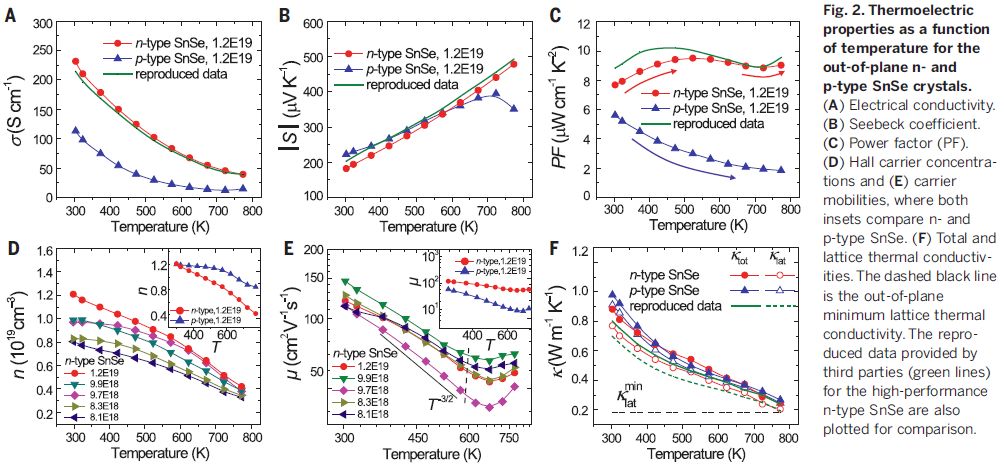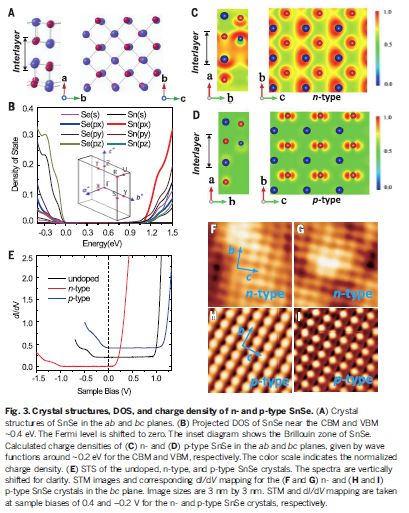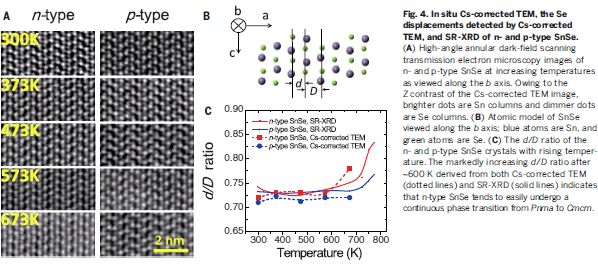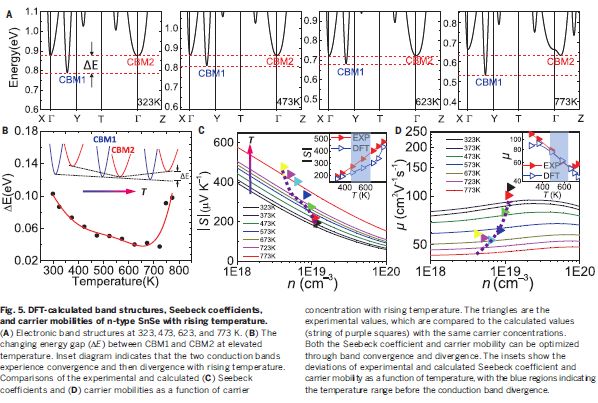On May 17th, Eastern Time, Science published a research paper titled 3D charge and 2D phonon transports leading to high out-of-plane ZT in n-type SnSe. It was reported from Prof. Zhao Lidong of Beihang University and He Jiaqing of South University of Science and Technology. Prof. Li Jingfeng, Prof. Qing Hua, Shanghai Institute of Applied Physics and Dr. Zhu Fangyuan of Shanghai Institute of Applied Physics, and the cooperation team led by Prof. Chen Yue from Hong Kong University are the latest achievements in the research of high-performance thermoelectric materials. It is worth mentioning that the author and unit of this paper are all from China, indicating that Chinese scholars continue to maintain their international leading position in the field of thermal power. Through a series of experimental tests and theoretical calculations, the research team elucidated the mechanism of three-dimensional electron transport of n-type SnSe, in which the overlap of out-of-plane electron orbits and the conduction band optimization caused by continuous phase transition are two key factors. More importantly, the test results of the research team were independently verified by a third party organization. The thermoelectric effect was discovered by the German aristocrat Seebeck for the first time in 1821 (also known as the earliest Volta found first in the frog experiment). It converts heat directly into electricity or electricity into heat, so it is used for waste heat recovery and cooling. There are potential applications in many fields, such as thermal management. For example, the current star cruise is powered by the thermoelectric effect. Although the phenomenon of thermoelectricity has been nearly 200 years old, Professor Zhao Xinbing, the chairman of the Thermal Power Branch of the China Materials Research Society, who has just left office, still sees the thermoelectric material as a small boy of 200 years old. There are still many annoyances: Nearly 20 years Although the thermoelectric material research is very active, it has been placed on high-grade thermoelectric performance orders of magnitude, and there has been no major breakthrough so far. The difficulty is obvious, and the high thermoelectric figure of merit ZT requires materials with both high conductivity and Seebeck coefficient and low thermal conductivity, and is a live bear paw and shark fin in the science field. Even children know that metals are both electrically and thermally conductive, ceramics are both insulated and thermally insulated, and the high Seebeck coefficient can only be found in semiconductor materials. In 2014, Dr. Zhao Lidong and his collaborators at Northwestern University in Nature reported ultra-low thermal conductivity SnSe single crystals. The thermoelectric properties of the material were within the in-plane b-axis, reaching 2.6. 2015, Beihang, Northwestern United States University, South University, University of Michigan, and the California Institute of Technology team also reported in Science that hole-doped SnSe single crystals have an ultra-high power factor, enabling the device's thermoelectric figure of merit to reach a record 1.34. These findings have made the study of single crystal SnSe a hot spot in the field of thermoelectricity. According to Google academic data, these two papers have been cited more than 1,800 times in just a few years. In today's Science paper, the Chinese team pushed the excellent thermoelectric properties of SnSe single crystals even further. In recent years, the strategy for improving the thermoelectric value has been either to increase the power factor through energy band engineering or to reduce the thermal conductance through heterostructure and interface phonon scattering. The extremely low thermal conductivity of SnSe makes its materials have intrinsic high thermoelectric properties. However, the thermoelectric properties of layered materials such as SnSe have been mainly concentrated in the surface. Although its out-of-plane thermal conductivity is very low, its electrical conductivity is not good, limiting its thermoelectric value. The researchers found that this difficulty can be solved by n-type doping. As shown in Fig. 1A, the Br-doped n-type SnSe thermoelectric value is much larger than the large p-type, up to 2.8, and has been verified by the third institution. The mechanism is shown in Figure 1B. Unlike p-type, n-type SnSe electron transport is not limited to in-plane. This in-plane out-of-plane 3D electron transport is extremely rare in 2D layered materials. A more detailed comparison can be seen in Fig. 2. It can be seen that the out-of-plane Seebeck coefficient and thermal conductivity of n-type p-type SnSe have little difference, and the carrier concentration does not differ much. The difference in conductivity is mainly due to the fact that the carrier mobility is up to twice the difference. Through DFT first-principles calculations, the researchers discovered that n-type SnSe electrons are three-dimensionally distributed and electron orbitals overlap out-of-plane, while p-type SnSe electron transport is limited to in-plane, as shown in Figure 3. This difference was also confirmed by scanning tunneling microscopy experiments. By spherical aberration correction transmission electron microscopy, the researchers revealed a continuous reversible phase transition of SnSe from the Pnma to Cmcm structure during heating, as shown in Figure 4, while the highly symmetric Cmcm structure further improves the electron mobility. The DFT calculations based on the experimental structure show that the conduction band structure of n-type SnSe leads to a balanced and optimized Seebeck coefficient and conductivity, and is also very important for maintaining its high thermoelectric performance. The realization of unusual three-dimensional electron transport in two-dimensional layered materials is undoubtedly a very exciting discovery, providing a new direction for optimizing the thermoelectric properties of layered materials. China is the largest country in international thermoelectric research. Many important achievements have emerged in recent years. Professor Zhao Xinbing believes that the establishment of a new theoretical system for the breakthrough development of thermoelectric materials in the future, and the development of new application fields that restrict the sustainable development of thermoelectric materials and applications, will be the future of thermoelectric research. The direction. Today, the latest experimental and theoretical results of the Chinese team have taken another step toward this goal. This report was independently produced by Zhishe and failed to verify and verify with the author. In case of omissions, omissions and inaccuracies, the responsibility lies with the agency. The handheld addresser is used to program the address of the monitoring module offline. When in use, connect the two output wires of the handheld encoder to the communication bus terminal (terminal label 1, 2) of the monitoring module, turn on the black power switch on the right side upwards, and press "ten Add", [Subtract ten", [Add one place" and [Subtract one place" to program the address. Hd Encoders,Twitch Encoder,Resolver Encoder,Incremental Rotary Encoders Changchun Guangxing Sensing Technology Co.LTD , https://www.gx-encoder.com